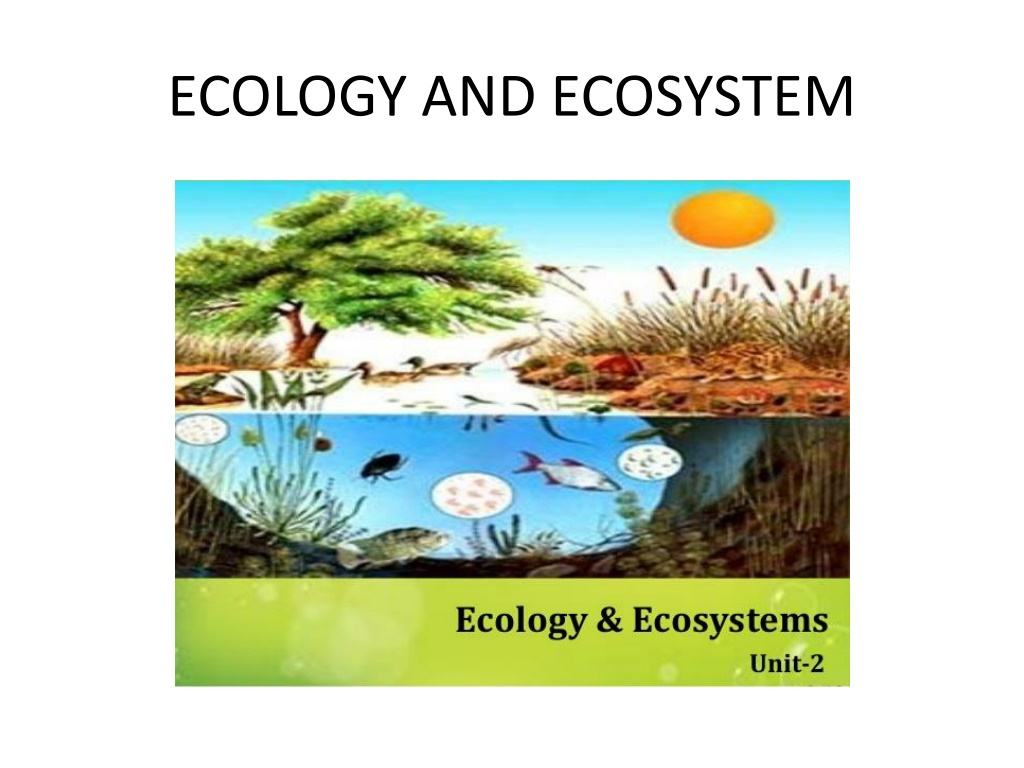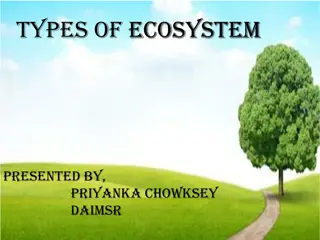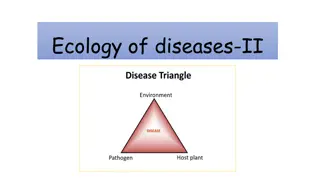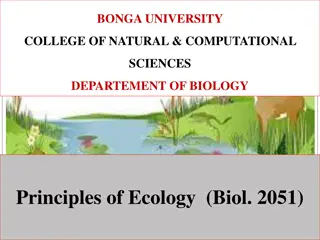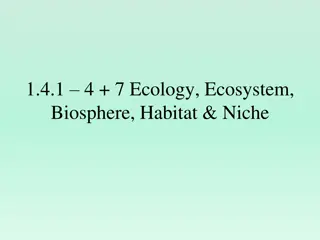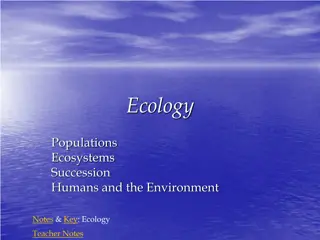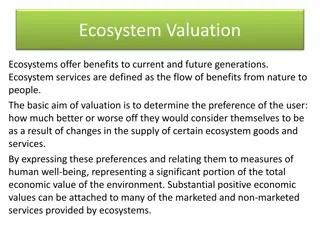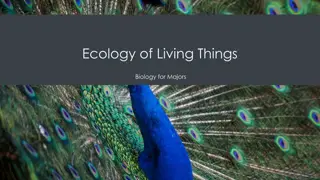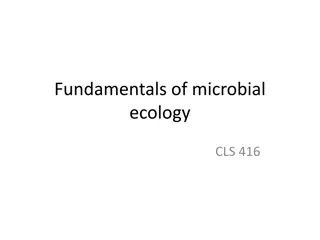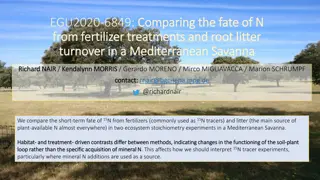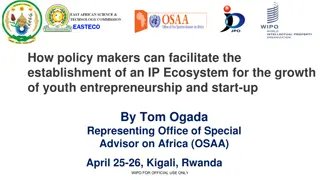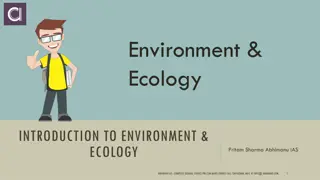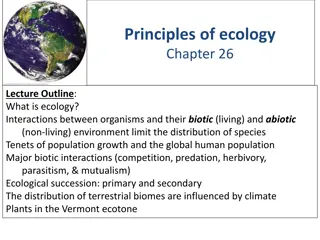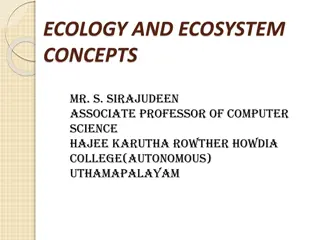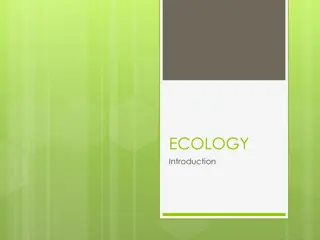Understanding Ecology and Ecosystem: A Comprehensive Overview
Ecology, derived from the Greek word "oikologie," explores the interactions between organisms and their environment. The study encompasses various branches like human ecology, population ecology, and habitat ecology, focusing on the relationships within ecosystems. An ecosystem, defined by A.G. Tansley in 1935, comprises living and non-living components that interact to maintain a stable system through biogeochemical cycles and energy flow.
Download Presentation

Please find below an Image/Link to download the presentation.
The content on the website is provided AS IS for your information and personal use only. It may not be sold, licensed, or shared on other websites without obtaining consent from the author. Download presentation by click this link. If you encounter any issues during the download, it is possible that the publisher has removed the file from their server.
E N D
Presentation Transcript
ECOLOGY AND ECOSYSTEM .The word ecology is derived from Greek word oikologie means Study of nature. .Greek word oiko means Home, logy means Study .The study of interactions between an organism and its physical environment ,the relationship between animals and plants and how one species affect another.
Ecology and Ecosystem The word ecology was firstly discovered by Reiter 1885,coined by Ernst Haeckel Characteristics of Ecology The scientific study of organism in relation to their environment.
ECOLOGY AND ECOSYSTEM Types of Ecology 1. Auto Ecology : concerned with the study of the interrelationship of individuals. Example: Study of any population 2. SynEcology : Concern with the study groups of organism. Example: Study of any community. Specialised Branches of Ecology 1. Human ecology: Study of man. Mans relation to the environment.
Ecology and ecosystem Specialised branches contd... Population Ecology: It is the study of growth, structure and regulation of population of organism. Habitat Ecology: It is the study of different habitats on the earth and their effects on the organism Production ecology: Deals with the production of different ecosystem like Fresh water, sea water. System Ecology: It deals the analysis and understanding of the structure and function of ecosystem
Ecology and ecosystem Ecosystem: Structural and functional unit of Ecology. The term ecosystem coined by A.G.Tansley1935 An ecosystem is defined as a natural unit that consist of living and non living parts which interact to form a stable system. Function: 1. Biogeochemical cycle 2. Unidirectional flow of energy
ECOLOGY AND ECOSYSTEM Species: A group of individual which can interbreed among them selves to produce a fertile offspring. Population: A group of similar species living together under the same environmental condition. Community: A group of similar and dissimilar species living together under more or less same environmental condition. Biome: Several types of complex community.
ECOLOGY AND ECOSYSTEM Role of sunlight: 1. Photosynthesis 2.Transpiration 3. Growth and shape of the plant 4. Effect on animal, fruit, seed germination. Role of Temperature: 1. Metabolism 2. Hibernation 3. Aestivation 4. Migration and 5. Dormancy
ECOLOGY AND ECOSYSTEM Role of water: 1. Most living tissue is composed of a very high percentage of water, upto 90%. 2. Without water protoplasm of tissue can not survive. 3. Water is the medium by which mineral nutrient enter and translocated in plants. Role of soil: Provide water and nutrient and growing medium of organism.
ECOLOGY AND ECOSYSTEM CLASSIFICATION OF PLANTS DEPENDING ON LIGHT: 1.Short day plant: These are those whose flowering is stimulated by day lengths shorter than the critical day length. Eg: Salvia, Datura 2. Long day plant: These are those whose flowering is stimulated by day length longer than particular value. Eg: Brassica 3. Day Neutral: Intermediate plants are those whose flower have neither too short nor too long photoperiod. Eg: Gossypium, Solanum
ECOLOGY AND ECOSYSTEM CLASSIFICATION OF ANIMALS DEPENDS ON TEMPERATURE: Eurythermal OR Homoeothermic organism: The organism which can tolerate very large fluctuation of temperature are called Eurythermal organism. Eg: Cyclops, Man etc Stenothermal OR Poikilothermic Organism: The organism which can tolerate very small variation in temperature are called stenothermal. Eg: Reptiles, Amphibian etc
ECOLOGY AND ECOSYSTEM Classification of plants depends on temperature tolerance: 1. Megatherms: Plants growing in regions where high temperature prevail through out the year. Eg: Desert vegetation, Tropical Rain forest 2. Mesotherms: Plants of the regions where high temperature alternating with low temperature. Eg: Tropical deciduous forest and aquatic plants. 3.Microtherms: Plants of the region where low temperature prevail throughout the year. Eg: Mixed coniferous forest. 4. Hekistotherms: Plants growing in regions with very low temperature. Eg: Alpine vegetation
ECOLOGY AND ECOSYSTEM Function of ecosystem: 1.REGULATORY FUNCTION: A. Gas regulation B. Climate regulation C. Water regulation D. Soil retention E. Nutrient regulation F. Waste Treatment 2. SUPPORTING FUNCTION: 1. Supportive habitat. 2. Soil formation
ECOLOGY AND ECOSYSTEM Function: 3. Provisioning Functions: A. Food B. Raw material C. Water Supply D. Genetic Resources E. Provision for shade and shelter F. Pharmacological resources.
FOOD CHAINS AND FOOD WEBS FOOD CHAIN: The transfer of food energy from the source in plants through a series of organisms with repeated eating and being eaten is known as the food chain. Types of Food chain: 1.PREDATOR FOOD CHAIN: A predator food chain starts from green plants and extent upto carnivores. Here the size of the living organism gradually increases but their number gradually diminishes. Eg: Grass-Grasshopper-Frog-Snake-Peacock 2. PARASITIC FOOD CHAIN: A parasitic food chain goes from larger host to smaller parasite. Eg: Plant-Pig-Helminth 3. SAPROPHYTIC FOOD CHAIN: A saprophytic food chain goes from dead organisms or organic matter into micro organism. Eg: Dead animal-Maggot-Frog-snake-Peacock
ECOLOGICAL SUCCESSION Ecological succession is a gradual process of change a and replacement of the types of species in a community. TYPES OF ECOLOGICAL SUCCESSION: There are two types of ecological succession. 1. Primary succession: It is a process of creating life in an area where no life existed earlier. Primary succession begins in a place without any soil to like: . Sides of volcanoes . Landslides . Flooding Primary succession starts with the arrival of living things such as lichens that do not need any soil to survive. When lichen die they decompose, adding small amount of organic matter to the rock to make soil. Then simple plants like mosses and fern can grow on this new soil. Then simple plants die, adding more organic materials, soil layer become thickens, grasses and other plants begin to take over.
ECOLOGICAL SUCCESSION Secondary succession: It is the process of re stabilization that follows a disturbance in an area, where life has formed an ecosystem. When an existing community has been cleared by any type of disturbance, such as fire, cyclone etc and the soil remains intact, the area begins to return to its natural community. Autogenic succession: Generally in a locality few pioneers will exist and soon gives rise to other community and again replaced by others until stable community is established. This type of development of vegetation which is formed as a result of reaction in the environment. Allogenic succession: In some cases habitat is changed by external factors such as gradual change in climate, filling up lake by silt. This may result in replacement of community.
